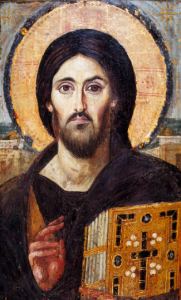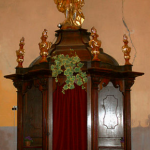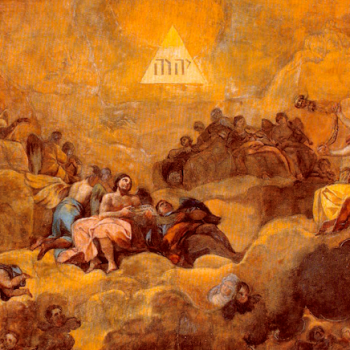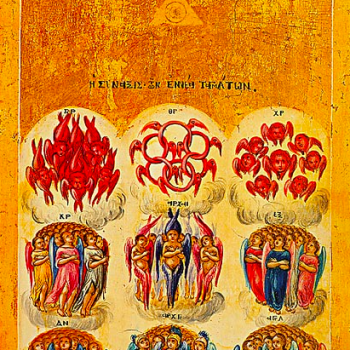Continuing from this introductory material.
John 7:37-39 and 20:19-23, RSV-CE
On the last day of the feast,b the great day,a Jesus stood up and proclaimed, “If any one thirst, let him come to me and drink.c He who believes in me, as the scripture has said, ‘Out of his heartd shall flow rivers of living water.’”e Now this he said about the Spirit, which those who believed in him were to receivef; for as yet the Spirit had not been given,g because Jesus was not yet glorified.
Α & Ω
On the evening of that day, the first day of the week, the doors being shut where the disciples were, for fear of the Jews, Jesus came and stood among them and said to them, “Peace be with you.”h When he had said this, he showed them his hands and his side.i Then the disciples were glad when they saw the Lord. Jesus said to them again, “Peace be with you. As the Father has sent me, even so I send you.” And when he had said this, he breathed onj them, and said to them, “Receive the Holy Spirit. If you forgivek the sins of any, they are forgiven; if you retain the sins of any, they are retained.”
Ikon of Christ Pantokrator from St.
Catherine’s Monastery on Mt. Sinai, one of
the few ikons of Jesus that predates, and
survived, the Iconoclasms (8th-9th cents.)
John 7:37-39 and 20:19-23, my translation
On the last, great day of the feast,a, b Jesus stood up and cried out, saying: “If anyone thirsts, come to me and drink.c He who believes in me, just as the Writ says, rivers will flow out of his insides,d of living water.”e This, he said about the Spirit, whom those who would believe in him were about to getf; for the Spirit was not there yet,g because Jesus was not yet glorified.
Α & Ω
Then, that being the evening of the first day of the week, and the doors closed where his students were out of fear of the Jews, Jesus came and stood in their midst, and said to them: “Peace to you.”h And having said this, he showed his hands and his sidei to them. Then his students were overjoyed to see the Lord. Then Jesus told them further: “Peace to you; just as my Father sent me, I too send you.” And having said this, he blew onj them and told them: “Receive the Holy Spirit; if you remitk anyone’s sins, they are remitted to them; if you hold onto anyone’s sins, they are held onto.”
Textual Notes
I have both translated and commented on the second of these passages before, so I’ll abbreviate my notes on that and concentrate more on a couple of things I had to leave out last time.
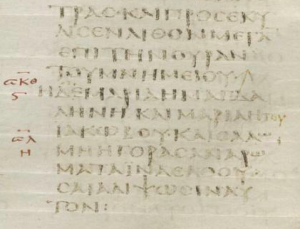
a. the feast: In this case, as we know from the earlier context of John chapter 7, we are dealing with Sukkot. This is also known as the Feast of Tabernacles, or occasionally the Feast of Ingathering (a name I assume comes from the fact that Sukkot corresponded to the autumnal harvest, the last before winter set in). This was another pilgrimage festival; its name is the plural of sukkah, meaning “tent, tabernacle, booth,” something every male Israelite would be bound to construct and then live in for at least part of the holiday; meals were normally eaten out in the sukkah even by any who were not sleeping there. Sukkot commemorated the tenderness of God as he shepherded Israel in the wilderness.
One of the practices of Sukkot was, and is, the waving of the “four species” (cf. Lev. 23.40). During certain prayers, these plants were to be waved in a gesture of celebration. The fact that the English renders two of these species with the un-specific phrases “goodly trees” and “thick trees” may indicate King James’ Hebraists weren’t up to the task in this passage, or may mean that the tradition which subsequently developed is only one possible interpretation; either way, the four species as observed today are:
- etrog [אתרוג]: the fruit of a citron (a type of citrus closely resembling the lemon1)
- lulav [לולב]: the frond of a date palm (lulav is also used as the name of the bundled species)
- hadass [הדס]: the branch of a myrtle (cf. Esther’s Hebrew name, Hadassah)
- aravah [ערבה]: the branch of a willow
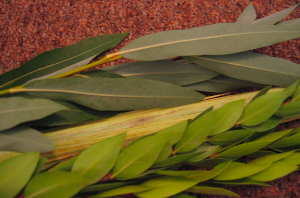
A prepared lulav, the bundle of branches
waved for Sukkot—back to front: willow;
palm; myrtle. Photo by D. Rosenbach, used
under a CC BY-SA 3.0 license (source).
All four of these are very “thirsty” trees; indeed, willows seek out water so assiduously that in some contexts, they practically count as weeds! This may have been one of the things that made the four species useful in the Holy Land in antiquity, as it is a watered land (lying south of the Anatolian mountains) but not, itself, a wet land. Besides this, the citron and date provide foods, and the citron is also fragrant; myrtle berries, while not necessarily that satisfying to just munch on, can be used to create a liqueur (though I gather this is done principally only in the Western Mediterranean, e.g. Sardinia) and as a pepper substitute. Willow branches, thanks to their unusual flexibility, are very useful in handicrafts. (If one wished, one could weave a willow basket in which to carry a citron, a cluster of dates, and a handful of myrtle berries.)
It is also striking, and has played a role in interpretations of the four species, that while all are present, none of these species are common in Canaan, and indeed, their ranges do not generally coincide2—meaning that most people would probably get to Jerusalem with one of the species, and need to get the other three from other visitors. Presumably there’s a lesson here about resourcefulness, hard work, independence, the spirit of the American frontier, etc.3
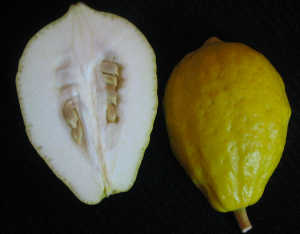
A citron. Similarities to the lemon are
obvious; however, note the distinctively
thick rind and fairly dry pulp. Photo used
under a CC BY-SA 4.0 license (source).
b. last day of the feast, the great day/last, great day of the feast: I think this probably mean the seventh day of Sukkot proper, the 21st of Tishrei. The alternative would be that it means Shemini Atzeret, the 22nd. This is a holiday that’s sort of appended to Sukkot—its name means “the eighth day of assembly”—and is, from what I understand, intended as a sort of low-key, affectionately-lingering observance; I got the sense it has something of the “optionally obligatory”4 quality that Catholic books on prayer assign to private thanksgivings after Mass. Of course, if this quality only developed later on, it could mean Shemini Atzeret, but I think the seventh day of Sukkot is much the stronger bet.
c. let him come to me and drink/come to me and drink: Two things merit note here. One is that this is one of a number of instances in the Gospels in which the authors use a curious grammatical form (one that, if memory serves, was effectively obsolete among native Greek-speakers at the time), the third person imperative. This works exactly like any other imperative, except that it is addressed to some third party and not, or not necessarily, the audience. (Here, it seems to be matched to the generic third person of “anyone.” Another use it could be put to was in “addressing” impersonal objects, as in the phrases “thy kingdom come” and “thy will be done,” which are also represented in the imperative.)

The other is why the imagery of water and drinking comes up at all. (Not that there are any strongly water-free stretches in John, but that’s not the point!) One of the rituals for Sukkot was called the Simchat Beth ha-Shoavah, “rejoicing at the house [or ‘place’] of the water-drawing.” So what was “the water-drawing”?
This was a rite performed on all days of the festival, except whichever of them was a sabbath. There were a minimum of two sacrifices every day in the Temple, evening and morning; the altar was generally “rinsed” with a libation of wine after the animal had been offered. During this festival, the morning libation was accompanied at the same time by a libation of water, drawn from the Pool of Siloam just outside Jerusalem; this was accompanied by dancing, singing, acrobatics—it was quite the spectacle! One of the authors who took part apparently said (and this remark made it all the way into the Talmud) that “he who has not seen the rejoicing at the Simchat Beth ha-Shoavah has never seen rejoicing in his life.” The origin of this water-libation seems to be unclear; some scholars tie it to prayers for rain over the ensuing winter, so the crops would grow. (There’s a nice, and rather more detailed, explanation of the ritual here.)
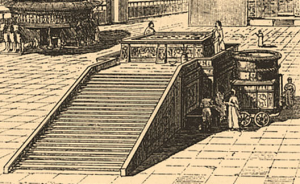
An artist’s conception of the altar that
stood in the courtyard of Herod’s
Temple (c. 1910).
So. After six days of the altar of the Temple being flooded with water, amidst what may have been the most raucous festivity of the year, seemingly out of nowhere (remember, he originally wasn’t even coming to this feast), Jesus emerges and says, in substance, “All this stuff we’ve been doing? It’s actually about me, and if you trust me, I’ll turn you into an altar just like this one.” Which, you know—it isn’t just that that could sound, maybe, egotistical; it’s also, I feel, just kind of a confusing thing to say!
d. heart/insides: The Greek here (κοιλία [koilia]) is a surprisingly difficult word to translate, given its simplicity. What it most literally refers to is “the (typically hollow) space inside of something,” like the socket of a joint or the stomach of the body; presumably for this reason, the womb can be a κοιλία. “Heart” really isn’t the right word for this—it brings in connotations that are both far too specific, and far too spiritually and imaginatively elevated, to convey the sense of the text. “Belly” is a common choice of translation here; I actually toyed for a while with “innards.”
e. living water: A little unluckily, we’ve gotten so used to this phrase in specifically Christian-ese contexts that we don’t often notice it any more. In classical antiquity, living water was an idiom meaning very nearly the same thing fresh water means today, and was certainly not reserved to religious contexts. This kept its meaning vivid (no pun intended).
f. were to receive/were about to get: There are a couple of reasons I like my translation here more than I usually do. One is just that I feel like it hit the sweet spot for simultaneous literalism and accessibility.

The second is, essentially, a pun based on that. You may recall that, according to John 1.5, the forces of darkness either “have not understood” or “have not overcome” the light; the Greek verb there, καταλαμβάνω [katalambanō], can mean either (much the way, in English, we can “master” a subject or “master” an opponent). Well, here we have the base verb λαμβάνω [lambanō], whose central meaning is “to take”: this occasionally takes on an intellectual sense as well (here the best English parallel is arguably “apprehend”). I don’t think the intellectual sense is being used in this passage, but I do find it rather funny that people were confused because the message was about a Spirit that they had not yet gotten.
g. as yet the Spirit had not been given/the Spirit was not there yet: Allowing for English’s weird rule that “‘There’ can be a dummy subject if you need one, and you need a dummy subject, pal”—as I was saying, allowing for that, my translation is pronouncedly the more literal. The only verb present in the clause about the Holy Spirit is “was,” hence the flat-footed literalness of the King James: “the Spirit was not yet”—doubtless a favorite text of the kind of profoundly niche personality that tries reviving the Pneumatomachian heresy.5

h. Peace be with you/Peace to you: This greeting was a commonplace in first-century Judæa, and is preserved in our liturgy: ‘Peace be with you’—’And with your spirit’ is, in the second half, merely an unusually literal rendering of the Latin. What is kind of funny is, the pre-revision responsory, ‘And also with you,’ is if anything closer to the original Hebrew than the Latin text. We can be almost certain that what Jesus actually said was שָׁלוֹם עֲלֵיכֶם [shalom ȝaleykhem], or “Peace be upon you”; the polite response to this was to reverse it and return it (often keeping the plural form even when addressing a single person): עֲלֵיכֶם שָׁלוֹם [ȝaleykhem shalom], “Upon you be peace.”
i. side: I’m far from the first to observe that, like the First Adam, whose wife (whom he named “Life”) was taken from his rib, the Second Adam also gives life to his bride from his πλευρά [pleura], a word that can be translated “rib” or “side.”
However, I’m rather struck here by the conceptual link between πλευρά and κοιλία from back up in note d on chapter 7. Both the Gospels and the medieval mystics (probably others as well, but those are the sources I recall off the top of my head) occasionally accent feminine or maternal elements in the person and role of Christ; it is arguable that, on the Cross and especially at the piercing, he becomes a kind of “male mother” to the Church, which finds an echo in the lament over Jerusalem, “as a hen gathers her chicks under her wings”.
The Medievals, meanwhile, got very bold with this imagery: Lady Julian’s blunt statement that “Christ is our Mother” is downright tame beside what, I’m told, St. Anthony of Lisbon said, that God wants us to nurse from his two breasts, the Incarnation and the Passion. (Would you look at that—a servant of “the Almighty, Maker of all that is visible and invisible,” using metaphors that clash with human habits of thought. Now I’ve seen everything.)
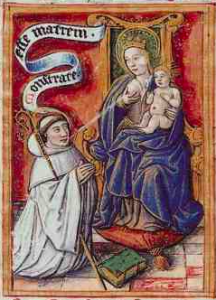
Yeah okay, I spoke one moment too soon:
now I’ve seen everything.6
j. breathed on/blew on: It does appear that this was gentler than the “rushing wind” of Pentecost, that so disarrayed the household the apostles were in the street in a matter of minutes. However, I do want to reiterate—mainly because it’s funny—that, if we go by the wording, this is not describing the gentle and inaudible “exsufflation” of the modern ordination rite; it’s describing huffing and puffing (as if to bring hell down). Like, this is the verb for working a set of bellows, which back then were, if I’m rightly informed, used chiefly for two purposes: heating blast furnaces to at least 1300 F°, so that you could make steel; or, supplying the wind to a pipe organ—an instrument that, even for a small one, is generally at least as big as a house.7
k. forgive/remit: This, I particularly wanted to come back to, after leaving it on the cutting room floor in my post about St. Thomas (the Apostle). Looking at the length of this piece however, and given the complexity of just what it was I wanted to explain about this … I’m doing a part three! (I guess that’s only appropriate, as Whitsunweek leads us into Trinity.)
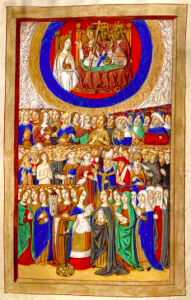
A page of a Book of Hours from the English
Renaissance; note the Trinity, depicted as
three humanoids (typically one Person is
symbolic, e.g. a dove for the Spirit).
Footnotes
1A bizarre fact I never seem to get tired of sharing is that most citrus fruits are a lie. There are naturally occurring citrus species: the citron (which looks like a knobbly lemon, except for the Buddha’s hand mutated variety), the kumquat (yes, really), the mandarin orange, the pomelo (which resembles a greenish-yellow grapefruit), and a handful of others. But basically every citrus fruit you find in the grocery store is a hybridization of at least two natural species, often more: lemons, for instance, while mostly citron, have ancestry from both mandarin oranges and pomelos as well.
2Citron trees grow on the Plain of Sharon, which forms most of the coast. Date palms grow principally near valley springs. Myrtle trees are found in the highlands, as, while they thrive in the heat of the Mediterranean, they prefer the cooler end that heat. Willows (probably the water-greediest of the bunch) mainly stick to riversides and lakeshores.
3This is a joke in more ways than one. Not only is generous cooperation, not self-reliance, the lesson of constructing a lulav; it was also the actual lesson of the American frontier. People who were too proud to accept help didn’t make it West.
4Or, to quote one of my personal favorite Yogiesque formulas, from the film 12 Monkeys: “Volunteer duty.”
5Pneumatomachianism was a heresy cooked up by Bishop Macedonius I of Constantinople (this was before it was created a patriarchate); apparently he thought the Quicunque Vult wasn’t repetitive enough. Long story short, it’s “What if the Son were consubstantial with the Father, but we did Arianism 2: Electric Boogaloo about the Holy Ghost instead?” This obnoxious, bad-faith loophole in the creed was promptly shut at the First Council of Constantinople in 381, at which Nicæa’s bare I believe in the Holy Ghost was extended to I believe in the Holy Ghost, the Lord and giver of life, who proceeds from the Father; who with the Father and the Son is worshiped and glorified; who spake by the prophets. (The name Pneumatomachi means “Spirit-fighter”: πνεῦμα [pneuma] “spirit” + μάχη [machē] “battle.”)
6This illustration is actually not, just, another example of medieval illuminators being rather strange people with an awful lot of time on their hands. It depicts what is known as “the lactation of St. Bernard,” a vision or miracle—doesn’t seem to be clear which one. The Mother of God is nursing the Holy Child, either in some work of sacred art, in versions where it’s a miracle, or in a dream Bernard has. I’m not clear whether or to what extent this next part is on purpose, but the Theotokos does squirt a jet of milk onto St. Bernard’s lips (sometimes clearing an impressive distance to do so); this grants him wisdom, usually, or sometimes cures an eye infection.
7Unrelated but interesting: pipe organs are far older than one might think. I vaguely associated them with the Baroque period, probably thanks to Bach, but the earliest pipe organs were being built in the third century BC.


